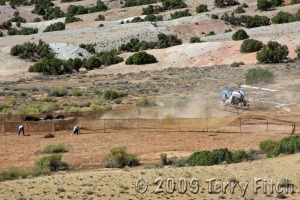Sacramento, Calif. – (July 15, 2010) – A lawsuit was filed to stop the Department of Interior‟s Bureau of Land Management (BLM) from rounding up and removing nearly 2,000 wild horses and burros from the Twin Peaks Herd Management Area north of Susanville, California.
The roundup, slated to begin in August, is the second largest capture and removal operation planned by the BLM for Fiscal Year 2010. The legal action was filed in the Eastern District of California on behalf of ecologist Chad Hanson, Ph.D., wild horse sanctuary founder Barbara Clarke, DreamCatcher Wild Horse and Burro Sanctuary, local resident and wild horse enthusiast Linda Hay, and the animal protection organization In Defense of Animals (IDA).
This lawsuit comes on the heels of Judge Larry R. Hicks of the U.S. District Court for the District of Nevada issuing a restraining order against the Department of Interior only 30 minutes after learning that DOI intended to round up more horses early this morning despite DOI‟s knowing that a hearing is scheduled later today regarding a Temporary Restraining Order sought by plaintiff Laura Leigh. On July 10, 2010, the BLM rounded up 228 horses in the Owyhee Complex in Nevada, with the vast majority being stampeded by helicopter for eight miles in searing summer heat. BLM reported that at least 12 mustangs, including colts 2 to 4 months old, have died thus far, with 7 suffering gruesome deaths within the first 24 hours of the roundup from dehydration-related causes, including brain swelling and “water intoxication.” Ms. Leigh‟s lawsuit and a separate administrative appeal filed by IDA and ecologist Craig Downer had warned BLM of the dangers in proceeding with this summer roundup so close to the foaling season.
“The Department of Interior‟s mismanagement of our public resources, so tragically revealed in the Gulf oil spill, extends to our nation‟s treasured wild horses and burros,” said Stuart G. Gross, of Cotchett, Pitre and McCarthy. “This suit aims to stop the agency‟s mass and illegal removal of federally-protected mustangs from the range to serve the livestock industry and other commercial interests that exploit our public lands.”
The complaint alleges that the planned roundup violates both the Wild and Free Roaming Horses and Burros Act and the National Environmental Policy Act, “The BLM‟s planned Twin Peaks stampede, roundup, removal, and off-site warehousing of these wild horses ignores the mandates and instructions of both laws in manner that is both arbitrary and capricious. In essence, the BLM has engaged in a classic example of crafting a solution and then searching for a problem.”
“The Twin Peaks roundup represents nearly one-third of the 6,000 horses the BLM intends to round up in the next four months. The vast majority of these horses will end up in zoo-like conditions in government holding facilities in the Midwest,” said Bill Spriggs of Buchanan, Ingersoll and Rooney. “This scheme is not only fiscally unsustainable, it is also blatantly illegal.”
“The Department of Interior has a policy of removing mass numbers of wild horses from the range without fulfilling its obligation to establish the need for the action,” said environmental attorney Rachel Fazio. “This circumvention of these legal requirements and the unfounded determination that 2,000 Twin Peaks wild horses and burros are „excess‟ is a cornerstone of this legal action.”
Plaintiffs in the litigation include ecologist Dr. Chad Hanson, a researcher at the University of California at Davis and author of numerous scientific studies, Barbara Clarke, wild horse expert and director of 2,000-acre DreamCatcher Wild Horse and Burro Sanctuary in Northeastern California, DreamCatcher Wild Horse and Burro Sanctuary, Linda Hay, a local resident who has visited and enjoyed the Twin Peaks horses for the past thirty years and In Defense of Animals.
Interior Secretary Ken Salazar has repeatedly stated the wild horse and burro program is not sustainable given that tens of millions of tax dollars are spent annually on the warehousing of wild horses in government facilities – yet the Department continues the same broken cycle of roundup-removal and stockpiling of wild horses contributing to the programs problems. The BLM consistently scapegoats wild horses and burros for range damage caused by livestock grazing. In Twin Peaks, for example, the BLM authorizes up to four times more cattle than wild horses, and nearly seven times more sheep than burros. The agency has the legal authority to limit livestock grazing in order to make more forage available for wild horses and burros, but routinely declines to pursue that option. Ecologists, wild horse experts and others support on-the-range management of the wild horses and burros as a means to maintain healthy herds and healthy range lands.
Wild horses comprise a small fraction of grazing animals on public lands, where they are outnumbered by livestock nearly 50 to 1. The BLM has recently increased cattle grazing allotments in areas where wild horses are being removed. Currently the BLM manages more than 245 million acres of public lands of which cattle grazing is allowed on 160 million acres; wild horses are only allowed on 26.6 million acres of this land, which must be shared with cattle. The Obama Administration has accelerated the removal of wild horses and burros from public lands in the past year. There are currently more than 36,000 wild horses warehoused in government holding facilities and only 33,000 wild horses free on the range.
The lawsuit was filed by Cotchett, Pitre & McCarthy, with offices in the San Francisco Bay Area, Los Angeles, New York and Washington D.C., the national law firm of Buchanan, Ingersoll & Rooney and San Francisco Bay Area-based environmental attorney Rachel Fazio.
CONTACT: Stuart Gross
Cotchett, Pitre & McCarthy
(650) 697-6000
www.cpmlegal.com
William Spriggs, Esq.
Buchanan, Ingersoll & Rooney
(202) 452-6051
Rachel Fazio, Esq.
(530) 273-9290
Eric Kleiman
In Defense of Animals
(717) 939-3231










No comments:
Post a Comment